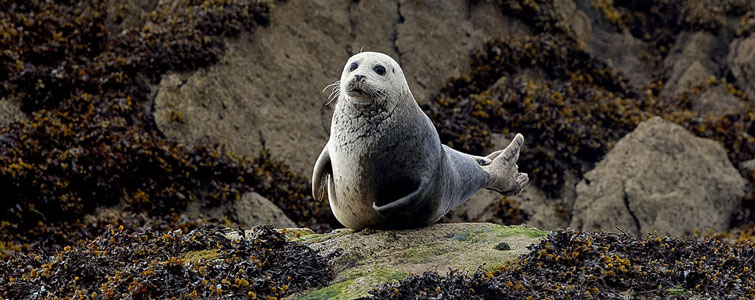Inishkea Islands in Co. Mayo

Inishkea Islands, in Irish Inis Gé meaning Goose Islands, are located 5 km off the Mullet Peninsula and lie between Inishglora to their north and Duvillaun to their south.
They are two main islands: Inishkea North and Inishkea South. They are composed of gneiss and schist ridges (200 million years old) containing an abundance of mica minerals and from a distance the islands shine silver and green. They are covered with fine sand and machair which form an unique habitat for the many species of flora and fauna; they are a haven for wildlife.
Flora is abundant on both of the islands and contains more than 200 plant species including wildflowers such as Northern Marsh Orchid, Bird’s-foot-Trefoil, White Clover, Tufted Vetches and Daisy. On Inishkea South Heather, Devil’s-bit Scabiuos and Sheep’s Bit grow, while Inishkea North is home to the rare petalwort Petalophyllum ralfsii.
They are home to a wide range of birds including rare birds such as Little Tern and Dunlin. Barnacle Goose is a visitor of the islands where it winters from October to April coming from Greenland. Up to 3000 Barnacle Geese have been recorded here making the islands an international site for these birds, where large flocks of them can be seen grazing grasses in the machair.
Many bird species benefit from the peace and protection of the islands and the wet areas and machair are ideal for waders including Dunlin, Lapwing, Redshank, Ringed Plover. Other resident and migrating birds are Snipe, Oystercatcher, Peregrine Falcon, Raven, Black Guillemot, Great Black-backed Gull, Herring Gull, Fulmar, Meadow Pipit and Skylark. In winter Golden Plover, Sanderling, Purple Sandpiper and Turnstone visit the islands.
On the Inishkeas the low lying coasts are one of the most important sites for Atlantic Grey Seal; about one third of the national population live here.
In Autumn (from mid-September to the end of October) females come ashore and give birth to single pup. It is estimated about 150 pups are born each year on the islands. In wintertime thousand seals can be seen on shore to moult.
Sometimes dolphins and whales along with basking sharks and Harbour Porpoise can be spotted out to sea between the islands and Blacksod Bay.
The islands boasts numerous Archaeological sites and in Early Christian times Saint Columba and Saint Brendan the navigator founded monasteries here; the remains of these monastic settlements can be still seen today. Inishkea North is best known for its early Christian monastery which flourished here between the 6th and 10th centuries AD. It is St Columba’s island.
On the south-west of the island there are the remains of a small church, dedicated to St Columba and built around 540. On the north-east there are three large mounds, known locally as the Baileys - the Bailey Mór, Bailey Beag and Bailey Dóighte meaning big, small and burnt. Archaeologists have found the ruins of a number of beehive huts, used by monks in the Early Christian period and some cross-slabs dating back to the late 7th to 8th centuries AD.
In 1946, French archaeologist Francoise Henry found traces of a dye workshop. It is thought the monks in an early Christian Monastery were producing purple colour from the shells of the dog whelks. There are also remains of a number of Megalithic Tombs, built during Neolithic period c.3500 to c.2000 BC.
On Inishkea South there are cross-slabs and pillars. One to the north of the harbour is a stone with a cross inscribed on it, located at the centre of two circles of stones. This appears to be a Pre-Christian monument 'christianised' at a later date.
In 1908 on Rusheen, a tidal island at short distance away from Iniskea South, a Norwegian company built a whaling station, which operated until 1922. The whaling station had a pier, two dams and some corrugated iron buildings, where blubber was boiled and potted. It is said about 50 whales were caught each year, mostly Finn, but also Humpies and Sperm.
In early nineteenth century the islanders revered a shaped rugger ball stone called “the Godstone” or “Naomhóg”; according to tradition, the stone had been St Columba’s pillow and had the powers of calming weather, speeding growth of potatoes, and quelling fire. Its was a bone of contention between the two islands and so the priest, Fr. O'Reilly, ordered its breaking and to throw it into the sea.
Last inhabitants were evacuated from the islands in 1932 after the Storm of October 27th, 1927.
